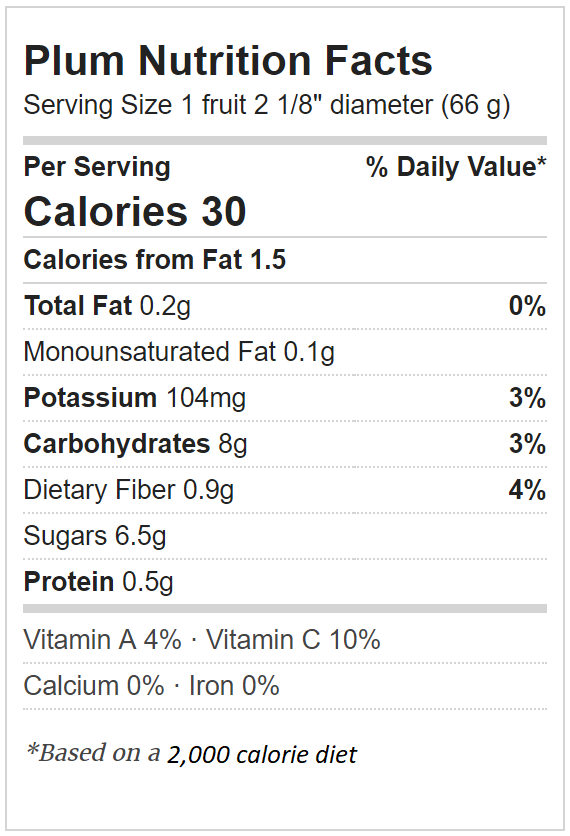Out of all the stone fruits – in fact, all fruits, plums are said to be the first fruit domesticated by the human race. Just as we have all read about olives, grapes, and figs in our history books, plums were right there as well in the most ancient of times. Over time, there have been discrepancies about how many species of plums there are – numbers range from 19 to 40! The small oval fruit has flesh that is firm on the outside, yet incredibly juicy on the inside. Color ranges from a blue/back to purple, and even green. You may be most inclined to relate plums to be a deep purple color due to media over time.
Plums
The average plum is likely to have around 46 calories in it with water content in the 85-percentile range. Talk about an ideal snack. These purple, pocket-sized juicers taste incredible when they are consumed at their peak. Not only do they bring hardly any calories to the table, they are also packed with vitamins ranging from vitamin C to vitamin A, vitamin K, vitamin B1, B2, B3, B6, B9, and vitamin E. Throw in potassium, magnesium, iron, calcium and zinc, and my friends, you have yourself a dietary fiber-filled snack that beats all odds.
Plums are used for indigestion relief, influenza infections and also serve as a highly depended on agent in anxiety-related situations. Yes, we are telling you there is a fruit that exists that tastes delicious, has everything good-for-you in it, AND helps calm anxiety. You heard us right! As if that wasn’t enough to boast about, plums also bring with them powerful antioxidants that are shown to aid in obesity, Alzheimer’s disease, and diabetes.
China stands as the world’s leading producer of plums to date, with Serbia, Iran, and Romania not far behind. The plum blossom, in fact, is considered a traditional emblem of China. Chinese mythology incorporated plums in their culture as linked to wisdom and were treated delicately and valuable. In terms of cultivating plum trees in today’s world, you are looking at a typical lifespan of 10-15 years. Fun fact: Plums are grown on every single continent except Antarctica. What does grow in Antarctica anyway? Cue us asking for a friend.
The way in which plums are enjoyed varies, but in our personal opinion, there’s nothing better than pulling a ripened plum off the branch and digging those incisors in. Some opt to cook plums into jams, bake them into pastries – and some opt for a bit of plum wine after a long day. Plum wine is more prevalent in Serbia, Japan, China, and Korea. In England, locals have taken a liking to plum jerkum, which is also an alcoholic beverage of choice.
Ever wonder what the difference is between plums and prunes? No? Well, we are going to tell you anyways because the more you know…the more you know. Prunes are the dried version of European plums. Prunes are a sticky and chewy snack, taste great and are still extremely nutritious. You can purchase prunes year round.
The truth is, we don’t have any real cons to report when it comes to plums. They really are as described in every way. Whether it be the ideal addition to a child’s lunch, a work break snack, or plum wine to wind down with, rest assured you and your loved ones are doing their body good.


Western Veg-Produce, Inc.
PO Box 82217
Bakersfield, CA 93380
Office: 1-800-WVegPro (983-4776)
Fax: 1-661-637-2365
Sales: sales@wvegpro.com
Accounting: accounting@wvegpro.com


